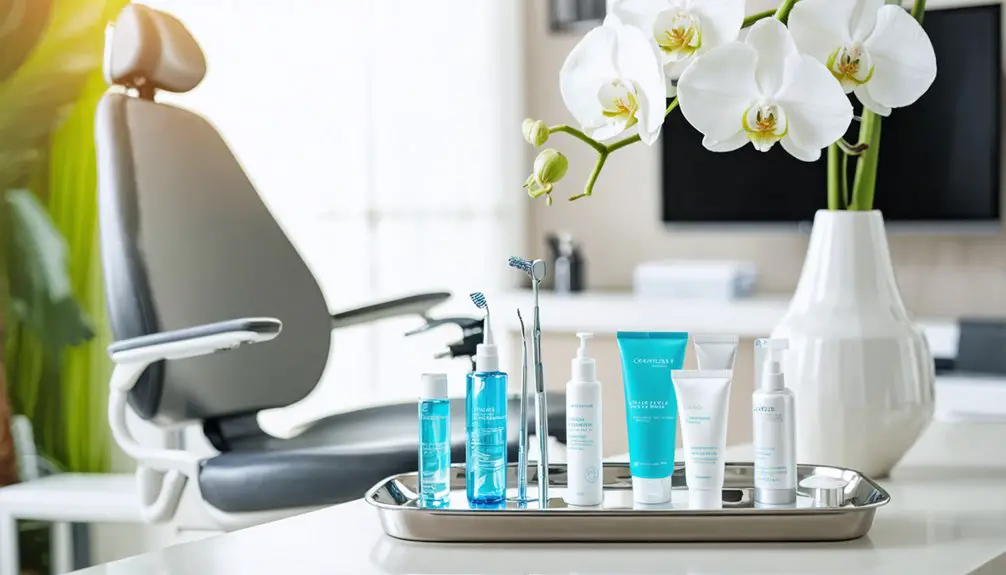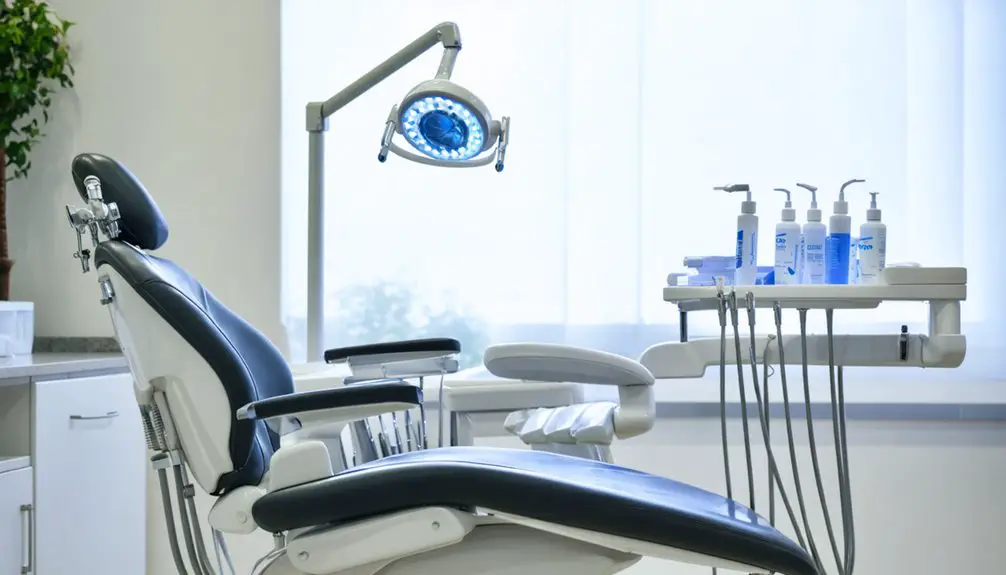You’ll find the most effective solutions for stubborn tooth stains through professional whitening treatments that combine multiple approaches. In-office laser or LED procedures can target deep discoloration in 45-60 minutes, while custom-fitted trays with prescription-strength gels provide consistent at-home care. For resistant intrinsic stains, advanced options like porcelain veneers or dental bonding offer permanent coverage. A consultation with your dentist will reveal the ideal combination of treatments for your specific case.
Key Takeaways
- Professional laser-activated treatments use concentrated light energy to penetrate deep stains, delivering fast and effective results in 45-60 minutes.
- Custom-fitted trays with prescription-strength whitening gels ensure optimal contact and consistent coverage for stubborn discoloration.
- Deep bleaching protocols specifically target intrinsic stains using specialized peroxide formulations under professional supervision.
- Porcelain veneers provide a permanent solution for severely stained teeth that don’t respond to traditional whitening methods.
- Combining in-office treatments with take-home maintenance kits maximizes long-term results for resistant tooth discoloration.
Understanding Different Types of Tooth Stains

While maintaining a bright smile is a common goal, tooth stains can manifest in various forms that require different treatment approaches.
You’ll encounter two primary categories: extrinsic stains, which affect the outer enamel surface, and intrinsic stains, which develop within the tooth’s dentin layer.
Extrinsic stains typically result from lifestyle factors like coffee, tea, wine consumption, and tobacco use, appearing as brown or yellow discoloration on your tooth surface.
These respond well to professional cleaning and whitening treatments.
In contrast, intrinsic stains present deeper challenges, often appearing gray, brown, or orange, stemming from medication exposure, trauma, or genetic conditions.
Understanding your specific type of staining is essential for determining the most effective treatment strategy, as intrinsic stains usually require more intensive professional interventions.
Professional In-Office Treatment Options
For addressing stubborn tooth stains effectively, professional in-office treatments offer the most powerful and immediate solutions available.
Patients can achieve noticeable results in just one visit. Today’s advanced whitening techniques combine high-concentration peroxide gels with cutting-edge activation technologies to deliver dramatic results in a single visit. Advanced diagnostic assessment tools help determine the most suitable and safe treatment approach for each patient.
- Laser-activated treatments focus concentrated light energy on specific stained areas, accelerating the bleaching process while minimizing sensitivity.
- LED-based systems employ customizable blue light wavelengths to activate whitening agents more gently, ideal for patients with sensitive teeth.
- Deep bleaching protocols target intrinsic stains using specialized peroxide formulations and extended contact times.
- ZOOM and Opalescence Boost in-office procedures incorporate desensitizing agents and protective barriers, ensuring both comfort and effectiveness during your 45-60 minute treatment session.
Custom-Fitted Trays and Prescription Strength Solutions
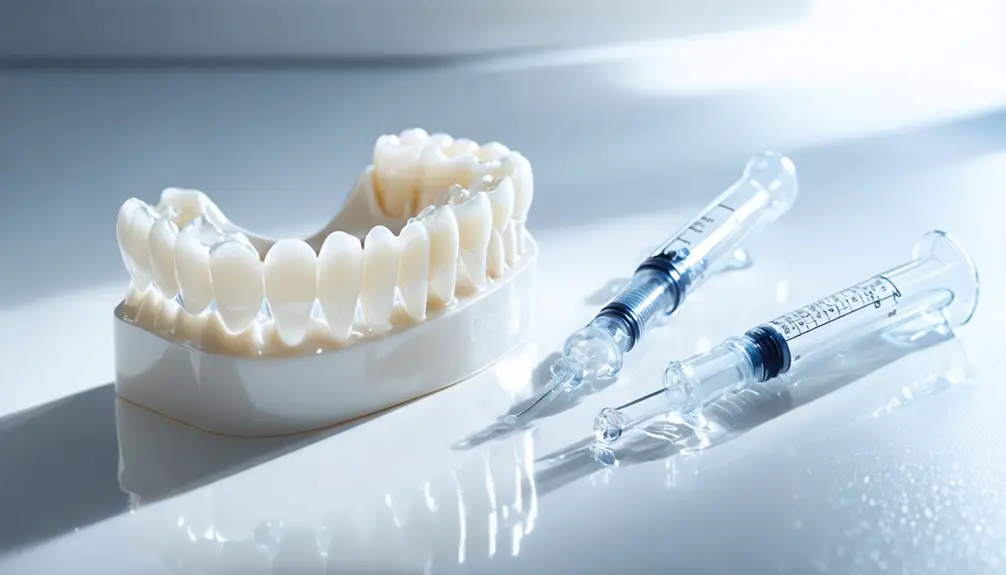
Custom-fitted trays combined with prescription-strength whitening solutions represent a highly effective at-home approach to professional teeth whitening.
These trays are precisely molded to your teeth’s unique contours, ensuring ideal contact between the prescription gel and tooth surfaces while minimizing gum exposure. The even distribution allows for consistent coverage across all teeth surfaces.
The prescription gel contains higher concentrations of active whitening agents than over-the-counter products, delivering deeper enamel penetration and more dramatic results. Professional supervision ensures safe and effective treatment throughout the whitening process.
Professional-grade whitening gels penetrate deeper into tooth enamel than store products, leading to more dramatic and transformative smile results.
You’ll achieve superior whitening outcomes, particularly for challenging cases like crooked teeth or stubborn stains.
Custom trays allow you to whiten at your preferred pace while maintaining professional oversight for safety.
The reusable nature of custom trays makes them cost-effective long-term, and you can easily perform touch-ups to maintain your results.
This combination of precise fit and professional-grade gel provides consistent, lasting results while protecting your oral health.
Advanced Dental Procedures for Resistant Discoloration
When traditional whitening methods prove insufficient for resistant discoloration, advanced dental procedures offer extensive solutions for even the most challenging cases.
Advanced techniques now available can transform patient experiences through customized treatment approaches.
- Professional bleaching with specialized agents targets deep intrinsic stains, utilizing accelerated activation methods for enhanced results.
- Porcelain veneers provide permanent coverage of severe discoloration while improving overall tooth aesthetics through custom-fitted ceramic shells.
- Dental bonding offers a less invasive option using tooth-colored resin to mask localized stains and imperfections.
- Full dental crowns deliver thorough coverage for severely discolored teeth while restoring both form and function.
Your dentist will evaluate your specific case to determine which advanced procedure best suits your needs, ensuring ideal outcomes for stubborn stain removal.
Combining Multiple Whitening Approaches
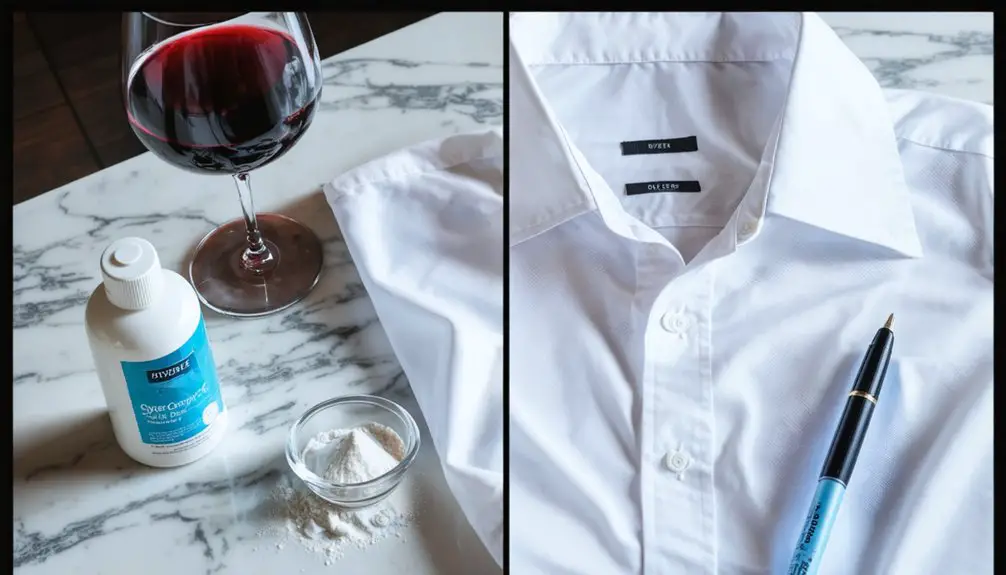
Maximizing the effectiveness of teeth whitening often requires a strategic combination of multiple professional approaches. You’ll achieve superior results by integrating in-office treatments with take-home solutions using custom-fabricated trays. This dual approach breaks through whitening plateaus while maintaining long-term results.
When combining multiple systems, you’ll start with LED or laser-activated in-office whitening to achieve rapid shade improvement within 1-2 hours.
Follow this with professional-grade gel applications using custom-fitted trays at home. These whitening techniques work synergistically over 2-4 weeks, depending on stain severity. Never use over-the-counter whitening strips during this professional treatment process.
For resistant cases, you can sequence different professional whitening systems, spacing treatments appropriately to protect enamel integrity.
Remember to monitor progress and adjust concentrations based on sensitivity levels and desired outcomes.
Maintaining Your Bright Smile Long-Term
You’ll need to establish consistent daily habits to protect your newly whitened teeth, including thorough brushing with a soft-bristled brush twice daily, flossing, and immediate rinsing after consuming staining substances.
For ideal long-term results, you should schedule professional touch-up treatments every six months while using dentist-provided at-home whitening trays between visits.
Your maintenance routine must also include strategic dietary modifications, such as limiting coffee, tea, and red wine consumption, while incorporating enamel-strengthening foods like dairy products and crunchy vegetables.
Daily Habits For Brightness
Maintaining a bright, stain-free smile requires consistent daily habits that protect your teeth from discoloration and buildup. By implementing effective techniques and making strategic dietary adjustments, you’ll help preserve your whitening results while preventing new stains from developing.
- Brush for two minutes twice daily using gentle circular motions with a soft-bristled toothbrush and whitening toothpaste.
- Rinse immediately after consuming staining beverages like coffee, tea, or red wine – using a straw when possible.
- Incorporate natural teeth-cleansing foods such as apples and carrots into your diet while limiting acidic and pigmented substances.
- Supplement your routine with antibacterial mouthwash containing hydrogen peroxide, and maintain proper hydration to promote natural cleansing through saliva production.
Using desensitizing toothpaste can provide significant relief from post-whitening sensitivity while helping maintain your bright smile.
Professional Touch-Up Schedule
While daily habits form the foundation of a bright smile, professional whitening touch-ups play a strategic role in long-term results.
You’ll achieve ideal enamel health by scheduling treatments every 6 to 12 months, allowing sufficient recovery time between sessions.
Your whitening frequency depends on specific factors like dietary choices and oral hygiene practices. If you consume staining substances like coffee or wine regularly, you may need more frequent touch-ups.
However, it’s essential not to over-whiten, as this can compromise your enamel and increase sensitivity.
Watch for signs that indicate you’re due for treatment: recurring yellowing, new stains, or diminished brightness despite good home care.
Your dentist will customize your touch-up schedule based on your unique needs while ensuring your enamel stays protected throughout repeated treatments.
Managing Sensitivity During Treatment
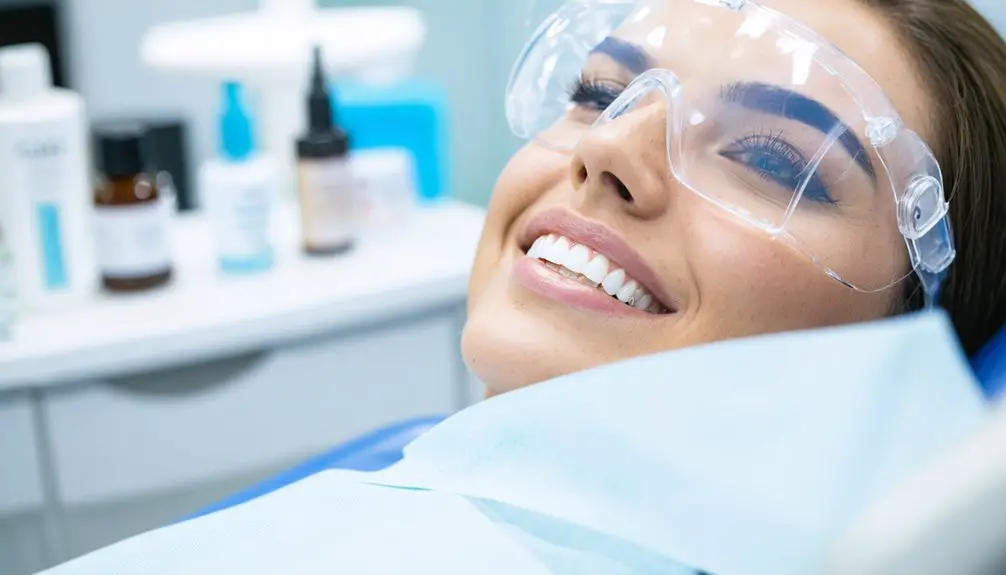
To effectively manage tooth sensitivity during whitening treatment, you’ll need to incorporate specialized desensitizing products containing potassium nitrate and utilize a gradual approach that allows your teeth to acclimate to the whitening process.
When treating stubborn stains, you’ll greatly reduce discomfort by avoiding hot or cold temperatures for 48 hours post-treatment and using custom-fitted trays that prevent gel contact with gums. Using products with lower peroxide concentrations can significantly minimize sensitivity while still achieving effective whitening results.
Your sensitivity management protocol should include pre-treatment with fluoride products, consistent use of desensitizing toothpaste throughout the process, and careful temperature regulation of foods and beverages during the whitening period.
Desensitizing Products and Methods
Since tooth sensitivity remains a primary concern during stain removal treatments, modern desensitizing products offer several effective solutions for managing discomfort.
You’ll find professional-grade options specifically designed to protect your teeth while achieving ideal whitening results.
- Start using desensitizing toothpaste containing 5% potassium nitrate 1-2 weeks before treatment to preemptively reduce nerve sensitivity.
- Schedule professional fluoride treatments immediately after whitening to strengthen enamel and minimize discomfort.
- Choose custom-fitted trays with controlled gel application to prevent gum irritation and sensitivity spikes.
- Apply strontium chloride or potassium nitrate-based products during treatment to block nerve pain signals effectively.
Your dentist can tailor these desensitizing methods based on your specific sensitivity levels and enamel condition, ensuring maximum comfort throughout the whitening process.
Gradual Treatment Approaches
Because teeth whitening can trigger sensitivity in many patients, implementing a gradual treatment approach helps minimize discomfort while achieving desired results.
You’ll want to focus on spacing whitening sessions appropriately to allow your enamel and dentin recovery time between treatments. Start with lower concentration peroxide gels, then carefully increase strength based on your patient’s tolerance.
Instead of lengthy single sessions, schedule shorter, more frequent treatments to reduce cumulative enamel stress. This gradual exposure method lets you monitor sensitivity responses and adjust treatment scheduling accordingly.
You’ll need to prevent overuse of whitening products by establishing appropriate intervals between applications. When combined with professional supervision, this measured approach optimizes results while protecting your patients’ dental health and comfort throughout the whitening process.
Temperature Control Tips
While managing tooth sensitivity during whitening procedures, temperature control plays an essential role in treatment success and patient comfort.
Professional temperature monitoring systems and strategic cooling techniques help prevent pulpal damage and reduce discomfort during your treatment.
- We’ll maintain strict temperature control below the critical 5.5°C increase threshold in your tooth’s pulp, utilizing real-time monitoring devices throughout your session.
- You’ll experience carefully timed cooling intervals between light applications, allowing your teeth to return to baseline temperature.
- We’ll use refrigerated whitening gels that preserve chemical stability while minimizing heat accumulation during activation.
- Your treatment will incorporate specialized wavelength selections and controlled exposure times if laser acceleration is needed, preventing thermal damage while maximizing effectiveness.
Choosing the Right Whitening Method for Your Case
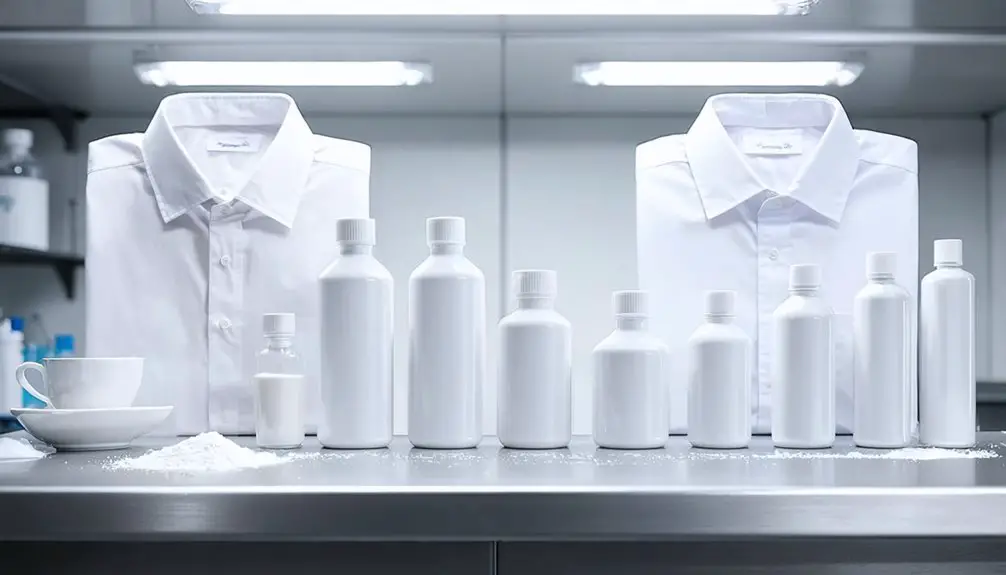
Selecting the best teeth whitening method requires careful consideration of multiple factors, including stain severity, time constraints, and sensitivity concerns.
Effective teeth whitening depends on understanding individual needs, from the depth of discoloration to time availability and tooth sensitivity levels.
If you’re seeking immediate results with precise treatment, laser whitening offers ideal outcomes within a single 60-minute session, though it’s more expensive.
For moderate whitening expectations and flexible treatment duration, LED-activated systems provide a balance of effectiveness and comfort. LED light devices can help accelerate the whitening process compared to traditional methods.
For severely discolored teeth resistant to chemical treatments, porcelain veneers present a permanent solution.
Consider professional tray-based whitening if you’re dealing with sensitivity issues, as it offers gradual improvement with minimal discomfort.
In-office treatments using peroxides deliver quick results but may require maintenance sessions.
You’ll achieve the best outcome by matching the treatment method to your patient’s specific needs and lifestyle requirements.
Prevention Strategies for Future Staining
Once teeth achieve their desired whiteness through professional treatment, implementing strategic prevention measures becomes essential for maintaining long-term results.
For ideal stain prevention, you’ll need to adapt your daily habits through targeted dietary modifications and protective practices.
- Strictly avoid dark-colored foods and beverages for the first 48 hours post-treatment, when your teeth are most vulnerable to staining.
- Utilize straws and protective drinking techniques to minimize contact between staining agents and tooth surfaces.
- Practice thorough oral hygiene with soft-bristled brushes, whitening toothpaste, and daily flossing.
- Schedule regular dental cleanings and implement a 30-minute waiting period between consuming acidic beverages and brushing to protect your enamel.
Staying well-hydrated by drinking plenty of water throughout the day helps naturally cleanse teeth and reduce stain accumulation.
These evidence-based strategies will help preserve your investment in professional whitening while maintaining ideal oral health.
Frequently Asked Questions
How Long Should I Wait Between Professional Whitening Treatments?
You’ll need to wait 6-12 months between professional whitening treatments for ideal results. This frequency protects your enamel, while treatment intervals depend on your sensitivity levels and oral health.
Can I Get Professional Whitening While Wearing Braces or Other Orthodontic Appliances?
You can undergo professional braces whitening, but you’ll need specialized trays to work around brackets. Your orthodontist can help prevent orthodontic stains while ensuring even results during treatment.
Will Whitening Treatments Affect the Bonding Material Used for Dental Repairs?
Whitening treatments won’t affect your dental bonding materials since they’re nonporous and resistant to bleaching agents. You’ll need to whiten your natural teeth first, then match new bonding to your desired shade.
Does Insurance Typically Cover Professional Teeth Whitening Procedures?
Like finding gold in a stream, insurance coverage for teeth whitening is rare. You’ll typically need to pay out-of-pocket since most providers classify whitening costs as cosmetic, not medically necessary.
Are There Any Medications That Could Interfere With Professional Whitening Treatments?
Various medication types can impact whitening effectiveness, including tetracycline antibiotics, chlorhexidine, antihistamines, and blood pressure drugs. You’ll need to disclose your medications to your dentist before treatment begins.
References
- https://www.knoxvillesmilecenter.com/blog/say-goodbye-to-stains-effective-teeth-whitening-solutions/
- https://www.cosmosmoderndental.com/teeth-whitening-for-intrinsic-tooth-stains/
- https://bestsmilesdentist.com/teeth-whitening-for-intrinsic-tooth-stains/
- https://collinsdentalcare.com/teeth-whitening-options-for-stains-caused-by-smoking-and-coffee/
- https://www.cpfamilydentistry.com/say-goodbye-to-stains-the-benefits-of-professional-teeth-whitening/
- https://www.arthurglosmandds.com/blog/types-of-tooth-stains/
- https://www.cocoabeachdentist.com/blog/2021/06/18/types-of-tooth-stains-remove/
- https://pubmed.ncbi.nlm.nih.gov/16262034/
- https://www.dentalcare.com/en-us/ce-courses/ce491/staining-types-and-causes
- https://www.martinezdentistryindy.com/blog/types-of-tooth-stains-and-how-to-get-rid-of-them/

